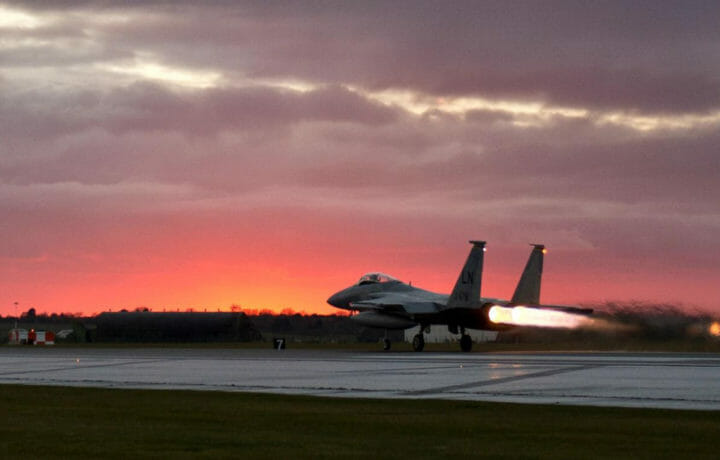The “Eagle has landed” in a way at Nellis Air Force Base (AFB), NV, as the United States Air Force announced on December 31 that it has ended the Air Force Weapons School Weapons Instructor Course for the F-15C Eagle, the single-seat fighter that first entered the service’s fleet in 1979. Weapons officers have been trained on the fourth-generation aircraft’s tactics at the Weapons School at Nellis since 1978.
The move is part of the U.S. Air Force’s continuing efforts to modernize its future fighter force, and that included the sunset of the F-15C Eagle training. The years of tradition with the F-15C all-weather fighter officially ended on December 8, as the last cadre of students and instructors took part in a defensive counter air vulnerability training flight for Weapons Instructor Course 21-B. This doesn’t mark the end of the F-15C just yet for the Air Force. The service has operated a total of 254 F-15C/D aircraft – including 222 in the active Air Force and an additional 32 in the Air National Guard.
“I love the F-15C,” explained Maj. Rodolfo Cruz, director of director of operations for the 433rd Weapons Squadron and one of the last five WIC instructors for the F-15C.
“We always brag about the record of 104-to-zero and that is predominately based on the fact that we have the air superiority fighter,” added Cruz, who has been an F-15C instructor since 2019. “I don’t want it to die, but we have to move on, because if we continue to rest on our laurels, it’s going to make the fight that much harder for us.”
Adoption of More Modern Aircraft
Even as the U.S. Air Force maintains that no Eagle has ever been shot down in air combat, the fighter is well past its prime.
“The F-15 has some advances, but it’s still the F-15 from the 1970s in a lot of ways,” said Maj. Michael Tope, WIC 21-B F-15C class leader. “That speaks to the capabilities of the maintainers and the people who have worked on the jets, as well as the instructors who have developed different tactics.”
However, at the Air Force Association’s annual Air, Space & Cyber Conference last September, Gen. Mark Kelly, commander of Air Combat Command, discussed the Air Force’s future fighter roadmap.
“We must move the Air Force from seven different platforms toward four plus one,” Kelly said at the conference. “We must keep the F-22 (Raptor) dominant for air superiority in a highly contested environment and facilitate a hot handover with our Next Generation Air Dominance capability.”
Weapons Fighter School in Transition
The end of the Air Force Weapons School Weapons Instructor Course for the F-15C will likely result in a few changes at the base, even as its sixteen F-15Cs will be relocated to other locations, including various Air National Guard bases or to Eglin AFB, Florida for test missions.
Others may be sent to a depot for refurbishing or to long term storage at the Air Force’s “boneyard” in Arizona.
According to the Air Force, following WPS 21-B, Eagle AMU will deactivate, and maintainers will be assigned locally or will be relocated to meet the needs of the Air Force. Cruz and several other F-15C instructors will make a transition to the Air National Guard, while Tope has said that he will transfer to Eglin AFB to work with the F-15EX test and evaluation program.
This isn’t the first time that Nellis has undergone its own transition.
The Air Force Fighter Weapons School was first designated on January 1, 1954, when the Air Crew School graduated its last Combat Crew Training Class, which included gunnery instructor training.
Today’s Weapons School encompasses 19 weapons squadrons, teaching 26 Weapons Instructor Courses, four Advanced Enlisted Courses and 30 combat specialties at nine locations. It is currently headquartered at Nellis, which is home to 12 of the squadrons, while there are also detachments at Dyess AFB, Texas; Hurlburt Field, Florida; Little Rock AFB, Arkansas; Whiteman AFB, Missouri; Holloman AFB, New Mexico; Fairchild AFB, Washington; McChord Field, Washington; and Barksdale AFB, Louisiana.
Active Duty, Air National Guard, and Air Force Reserve officers may apply for admission to the school.
Weapons Instructor Course are provided for a variety of U.S. Air Force aircraft including the A-10 Thunderbolt, Lockheed AC-130, B-1 Lancer, B-2 Spirit, B-52 Stratofortress, C-17 Globemaster III, C-130 Hercules, F-15E Strike Eagle, F-16 Fighting Falcon, F-22 Raptor and MQ-9 Reaper.
Even as the sun sets on the F-15C program, the Air Force will begin to adopt the F-15EX, a modern version of the Cold War all-weather, multi-role fighter. Operational test missions had been conducted at Nellis AFB in October while additional testing will also be conducted at the base.




